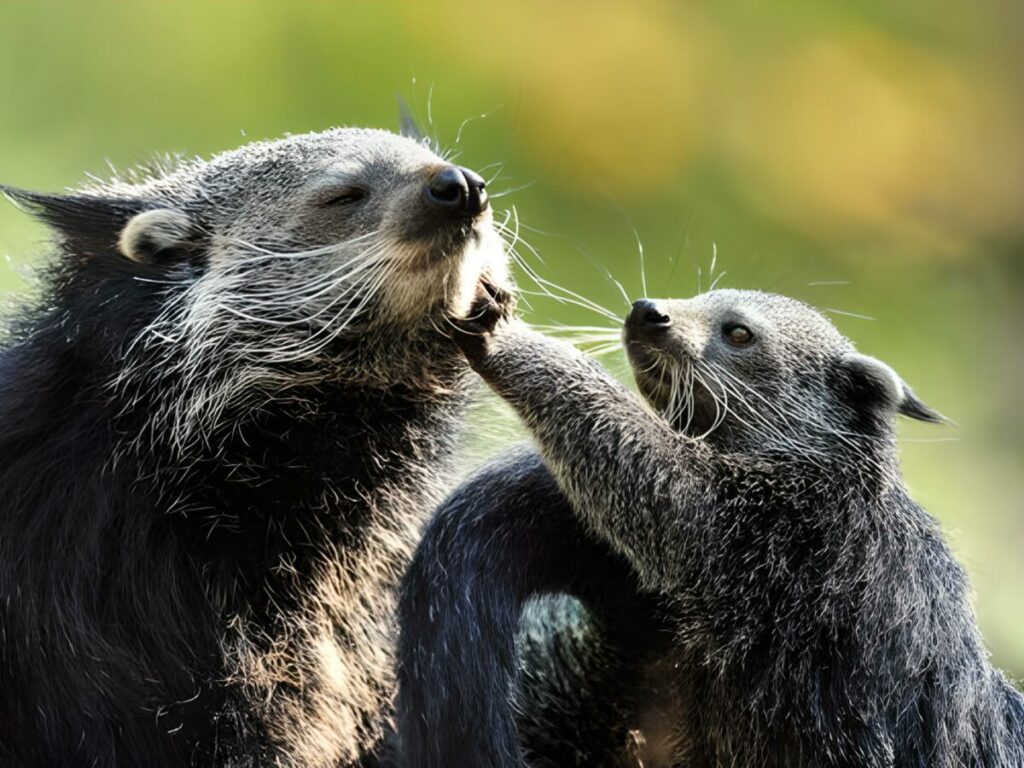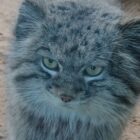Why does the Binturong smell like popcorn?

Often referred to as the bearcat due to its resemblance to bears and cats, the Binturong (Arctictis binturong) boasts a distinctive trait that sets it apart from its forest-dwelling counterparts: a peculiar aroma reminiscent of hot buttered popcorn.
Robust Arboreal Mammal
The physical characteristics of the Binturong reveal a creature uniquely adapted to its arboreal environment. Its fur, which appears dark brown to black, serves multiple purposes beyond mere aesthetics. The long, shaggy coat provides insulation against the fluctuations of temperature common in the tropical rainforest, helping the Binturong regulate its body heat amidst the humid climate. The coloration of its fur also aids in camouflage, allowing it to blend seamlessly with the shadows and foliage of its forest home, providing a crucial advantage against potential predators.
Binturong’s body is robust and well-built, featuring a muscular frame that supports its arboreal lifestyle. Its limbs are strong and flexible, equipped with sharp, curved claws that enable it to climb trees with agility and precision. Unlike some other arboreal mammals that rely solely on their limbs for movement, the Binturong possesses a remarkable adaptation in the form of a prehensile tail. This tail, which is strong and muscular, acts as a fifth limb, aiding in grasping branches and maintaining balance while navigating the complex canopy structure.
The head of the Binturong is characterized by a set of large, round ears that provide exceptional auditory sensitivity. This keen sense of hearing allows the Binturong to detect subtle sounds in its environment, including the movements of potential prey or the approach of predators. Coupled with its acute sense of smell, which is among the most developed in the animal kingdom, the Binturong possesses a formidable array of sensory capabilities that enhance its survival in the dense, often dimly lit rainforest canopy.
The overall silhouette of the Binturong, with its stout body, rounded ears, and bushy tail, contributes to its bear-like appearance, earning it the nickname “bearcat” among locals and observers.
Binturong Are Solitary
Binturongs are predominantly nocturnal creatures, choosing to venture out under the cover of darkness when the forest comes alive with activity. This nocturnal lifestyle helps them avoid predators and efficiently forage for their diverse diet. They are opportunistic feeders, consuming a wide range of foods including fruits, leaves, small mammals, birds, eggs, and even insects.
One of the most intriguing aspects of Binturong behavior is their arboreal nature. They are adept climbers, using their strong limbs and prehensile tail to navigate the intricate network of branches in the forest canopy. This arboreal lifestyle offers them protection from ground-dwelling predators and allows them to access food sources that are out of reach for many other animals.
Despite their solitary tendencies, Binturongs are not entirely antisocial. They have been observed engaging in social interactions, particularly during the breeding season. Males may compete for access to females, engaging in vocalizations and scent marking to assert dominance and establish territories. Females, on the other hand, exhibit maternal care and nurture their young until they are old enough to fend for themselves.
One of the most distinctive features of the Binturong is its scent, which serves multiple purposes in their behavioral repertoire. This scent is produced by specialized glands located near the base of their tail and is used for communication, marking territories, and possibly even deterring predators. The unique aroma, often described as reminiscent of popcorn or freshly baked bread, is a signature characteristic of the species.
Does the Binturong Really Smell Like Popcorn?
The chemical compound responsible for the aroma is 2-acetyl-1-pyrroline (2-AP), which also happens to be the major aroma emitted by freshly made popcorn. Researchers conducted a thorough analysis of urine samples from Binturongs at Carolina Tiger Rescue, a nonprofit wildlife sanctuary in North Carolina, to unravel the mystery behind this peculiar scent.
Binturongs possess scent glands under their tails, and during urination, they soak their feet and bushy tails, spreading their distinctive scent as they move through their environment. This behavior, combined with dragging their tails along branches and leaves, creates a lasting scent trail that serves as a territorial marker and a means of communication with potential mates. Interestingly, males secrete more 2-AP than females, suggesting a role in sexual signaling and territorial dominance.
Cooking without Cooking
The aromatic compound itself forms during the Maillard reaction, a complex chemical process that occurs during the cooking of foods like popcorn, toasted bread, and cooked rice.
One of the key questions raised by researchers was how Binturongs produce this compound without undergoing the cooking process. The answer lies in the interaction between their urine and the bacteria and microorganisms present on their skin, fur, and in their gut. These microbes break down compounds in the urine, including sweat, to produce distinct odors, much like the bacteria in our armpits contribute to body odor.
The time-release action of these microbes ensures that the Binturong’s scent markers persist long after the animal has moved on, making it an effective mode of communication for solitary creatures that rarely encounter each other.

Popcorn Kits
Female Binturongs typically enter estrus once or twice a year, marked by physiological and behavioral changes signaling their readiness to mate. During this period, males compete for the attention of receptive females through various displays of dominance and courtship rituals.
Once mating occurs, the female undergoes a gestation period lasting approximately three months before giving birth to a single offspring, occasionally twins in rare cases. The birthing process is a solitary affair, with the female retreating to a secluded den or hollow tree for privacy and protection. This behavior is believed to reduce the risk of predation and ensure the safety of the vulnerable newborn.
The newborn Binturong, known as a kit, enters the world blind, deaf, and entirely reliant on its mother for survival. The mother provides nourishment through lactation, nursing the kit until it is weaned at around four to six months of age. During this period, the kit’s senses gradually develop, allowing it to explore its surroundings under the watchful eye of its mother.
Learning to Climb and Hunt
As the kit grows, it begins to exhibit playful behaviors, honing essential skills such as climbing, balancing on branches, and foraging for food. These activities are crucial for the kit’s physical development and preparation for an independent life in the forest canopy. The mother plays an active role in teaching her offspring these skills, demonstrating techniques for locating food sources and avoiding potential predators.
Around the age of one year, the young Binturong reaches sexual maturity, marking the transition to adulthood. At this stage, it may leave its mother’s territory to establish its own home range and seek out potential mates. This dispersal helps maintain genetic diversity within the population and reduces competition among related individuals.
Conservation Status and Threats
One of the most pressing threats to Binturong populations is habitat loss and fragmentation due to human activities such as deforestation, logging, and agricultural expansion. As vast swathes of forest are cleared for timber, agriculture, and infrastructure development, the Binturong loses crucial habitat and resources essential for its survival. Fragmentation of forests further isolates populations, leading to reduced genetic diversity and increased vulnerability to environmental changes and disease.
As human populations expand and encroach upon natural habitats, conflicts between humans and Binturongs can arise. Farmers may view Binturongs as pests due to their occasional predation on poultry or crops, leading to retaliatory killings or habitat destruction to mitigate perceived threats.
Illegal Hunting and Changing Ecosystems
The Binturong is also targeted by illegal hunting and the wildlife trade, driven by demand for its fur, meat, and body parts in traditional medicine and cultural practices. Despite legal protections in many countries, enforcement of wildlife laws remains challenging, allowing poaching and trafficking to persist.
Rising temperatures, altered precipitation patterns, and extreme weather events can disrupt ecosystems, affect food availability, and increase stress on wildlife populations. Furthermore, resource depletion, such as overexploitation of forests for timber or unsustainable hunting of prey species, further exacerbates the challenges faced by Binturongs and other forest-dwelling animals.










